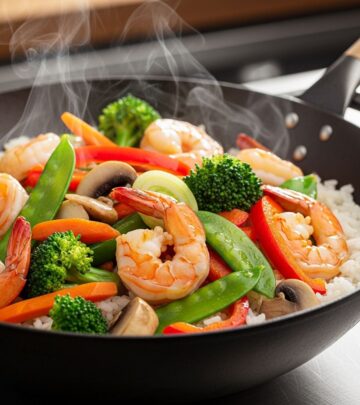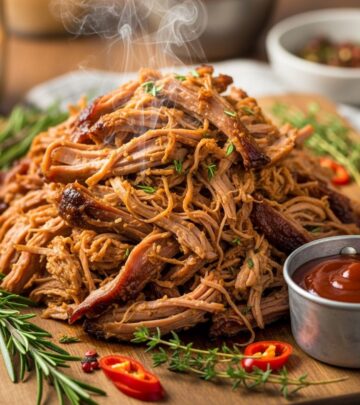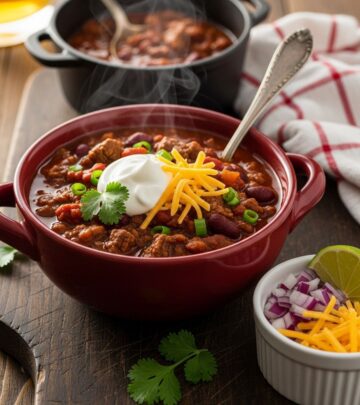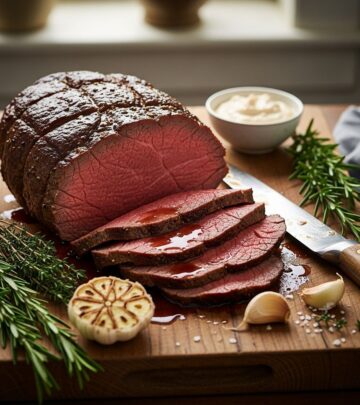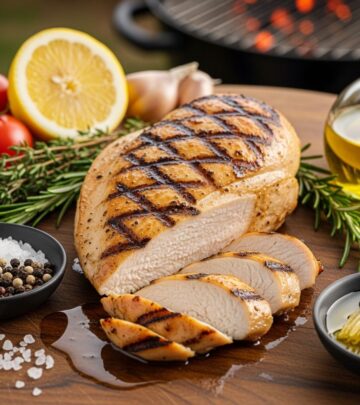Prime Rib Roast Recipe: Step By Step Guide To Perfect Roast
Discover how to prepare an impressive prime rib that's surprisingly simple to master
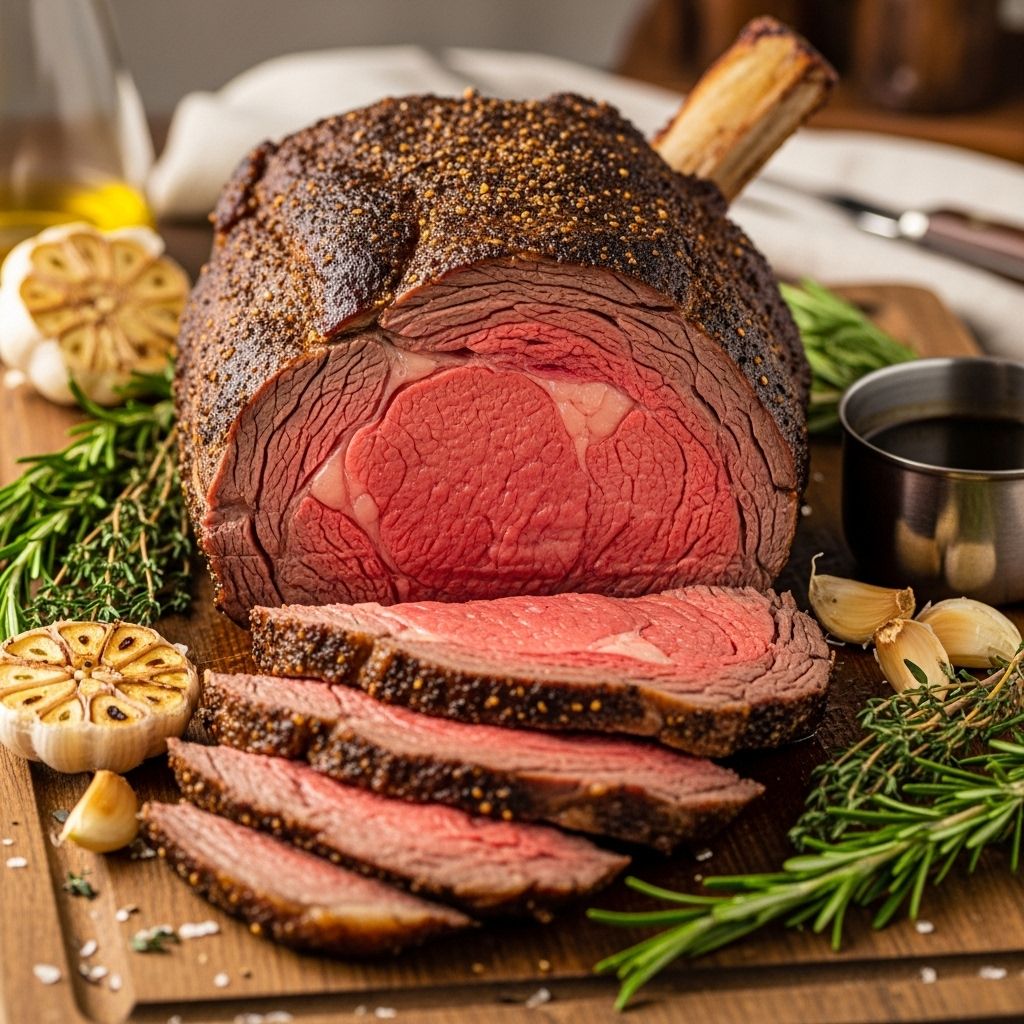
Image: HearthJunction Design Team
Prime Rib: Mastering the Art of Perfect Roasting
Prime rib stands as the undisputed champion of holiday roasts, a centerpiece that commands attention and reverence at any special gathering. Despite its reputation for difficulty, cooking the perfect prime rib is actually more straightforward than many home cooks realize. With the right techniques, quality ingredients, and a reliable meat thermometer, you can create a restaurant-worthy prime rib in your own kitchen that will have your guests talking for years to come.
Understanding Prime Rib
Before diving into preparation methods, it’s essential to understand what prime rib actually is. Prime rib comes from the primal rib section of the cow, specifically ribs 6 through 12. This cut features magnificent marbling, a protective fat cap, and meat that’s tender and rich in flavor. Contrary to its name, ‘prime rib’ doesn’t necessarily mean it’s USDA Prime grade (though it can be). The term refers to the cut itself, which can come in Prime, Choice, or Select grades.
When shopping for your roast, look for bright red meat with abundant marbling and a thick, white fat cap. For a formal dinner, plan on one rib for every two people. A 3-rib roast typically serves 6-8 people, while a majestic 7-rib roast can serve up to 16 guests. Whether you choose bone-in or boneless depends on personal preference, though many chefs prefer bone-in for its superior flavor development during cooking.
Essential Ingredients for Perfect Prime Rib
The beauty of prime rib lies in its natural flavor, which requires minimal enhancement. Here’s what you’ll need to prepare a standard 5-pound prime rib roast that serves approximately 8 people:
- 1 (5-pound) bone-in prime rib roast
- 2 tablespoons olive oil
- 2-3 cloves of garlic, minced
- 2 tablespoons steak seasoning (or a blend of salt, pepper, garlic powder, and herbs)
- 1 teaspoon kosher salt (adjust according to your steak seasoning’s salt content)
- 1 teaspoon freshly ground black pepper
- 1-2 sprigs of fresh rosemary (optional)
- 1-2 sprigs of fresh thyme (optional)
Equipment You’ll Need
Having the right tools on hand ensures your prime rib cooking experience goes smoothly:
- A reliable meat thermometer (digital instant-read is best)
- A roasting pan with rack
- Kitchen twine (if your roast isn’t already tied)
- Aluminum foil
- A sharp carving knife
Among these items, the meat thermometer is absolutely non-negotiable. Temperature, not time, is the only way to ensure your expensive cut of meat reaches the perfect doneness.
Preparation: Setting the Stage for Success
Proper preparation begins long before your roast enters the oven. Here’s how to set yourself up for prime rib perfection:
The Day Before Cooking
Remove your prime rib from the refrigerator and unwrap it. Pat it dry thoroughly with paper towels. If your butcher hasn’t already done so, you may want to trim some excess fat, but leave at least 1/4 inch of the fat cap intact to baste the meat while cooking.
Season generously with kosher salt and place the roast, uncovered, on a rack set inside a baking sheet. Return it to the refrigerator overnight or for at least 8 hours. This dry-brining process allows the salt to penetrate the meat, seasoning it thoroughly while also helping to retain moisture during cooking.
The Day of Cooking
Take your prime rib out of the refrigerator 2-3 hours before roasting. Allowing the meat to come to room temperature ensures more even cooking from edge to center. During this time, the surface will also dry slightly, which promotes better browning during roasting.
When you’re ready to cook, preheat your oven to 500°F (260°C). While the oven heats, prepare your seasoning mixture by combining olive oil, minced garlic, steak seasoning, salt (if needed), and pepper. Pat the roast dry once more, then rub this mixture all over the meat, ensuring every surface is coated. If using fresh herbs, tuck sprigs of rosemary and thyme around the roast.
The Cooking Method: A Two-Temperature Approach
The most foolproof method for cooking prime rib combines an initial high-heat sear with a gentle, low-temperature roast. This approach creates a flavorful crust while ensuring the interior cooks evenly to your desired doneness.
Step 1: The High-Heat Sear
Place your seasoned roast fat-side up on a rack in a roasting pan. Insert your meat thermometer into the thickest part of the meat, being careful not to touch bone, which conducts heat differently and will give a false reading.
Place the roast in your preheated 500°F oven for 15 minutes. This initial blast of high heat creates a beautiful crust that seals in juices and develops rich flavor through the Maillard reaction.
Step 2: The Low and Slow Finish
After the initial sear, without opening the oven door, reduce the temperature to 325°F (165°C). This dramatic temperature drop slows the cooking process, allowing the heat to penetrate the meat gently and evenly.
Continue roasting until your meat thermometer registers your desired internal temperature:
- Rare: 120-125°F (49-52°C)
- Medium-rare: 130-135°F (54-57°C) – Most recommended
- Medium: 140-145°F (60-63°C)
- Medium-well: 150-155°F (66-68°C)
- Well done: 160°F (71°C) and above
Remember that the internal temperature will continue to rise by 5-10 degrees during resting, so remove the roast when it’s 5-10 degrees below your target temperature. For a 5-pound roast aiming for medium-rare, expect a total cooking time of approximately 1.5 to 2 hours after the temperature reduction.
Step 3: The Essential Rest
Once your roast reaches the target temperature, transfer it to a cutting board and tent loosely with aluminum foil. Allow it to rest for at least 20-30 minutes. This crucial step allows the juices to redistribute throughout the meat instead of spilling out when carved, resulting in a more succulent roast.
During this resting period, you can prepare gravy from the pan drippings, finish your side dishes, or simply enjoy a well-deserved glass of wine knowing your main course is on track for perfection.
Carving and Serving Your Masterpiece
After the rest, it’s time to carve your beautiful creation. If your roast is bone-in, you have two options: carve the meat away from the bone in one piece and then slice, or slice between each rib to create magnificent bone-in servings.
For boneless carving, use a sharp carving knife to create slices about 1/2 inch thick against the grain. For bone-in presentation, carefully cut between the ribs to separate individual portions.
Serve your prime rib with classic accompaniments like creamy horseradish sauce, Yorkshire pudding, roasted potatoes, and seasonal vegetables. A bold red wine such as Cabernet Sauvignon or Bordeaux makes the perfect pairing to complement the rich flavors of the meat.
Troubleshooting Prime Rib Problems
Even experienced cooks sometimes encounter challenges with prime rib. Here are solutions to common issues:
Uneven Cooking
If your roast is cooking unevenly, it may be due to irregular shape or uneven temperature in your oven. To prevent this, ensure your roast has completely come to room temperature before cooking. You can also rotate the roast halfway through the cooking process if your oven has known hot spots.
Gray Exterior with No Crust
A lackluster exterior usually indicates insufficient initial heat. Make sure your oven is fully preheated to 500°F before the roast goes in, and don’t open the door during the searing phase. Also, ensure the roast surface is dry before seasoning and cooking.
Overcooked Exterior with Undercooked Center
This common problem usually stems from cooking at too high a temperature throughout. The two-temperature method described above helps prevent this issue. If your roast is very large (over 8 pounds), consider lowering the oven temperature to 300°F after searing to allow more gentle, even cooking.
Making the Most of Leftovers
Prime rib is a significant investment, so making the most of any leftovers is important. Properly stored in an airtight container, leftover prime rib will keep in the refrigerator for 3-4 days. Here are some delicious ways to enjoy it:
- Prime rib sandwiches with horseradish sauce and arugula
- Sliced thin and added to a beef vegetable soup
- Diced and used in breakfast hash with potatoes and eggs
- Sliced cold for a luxurious salad topping
For longer storage, you can freeze leftover prime rib for up to 3 months. Wrap it tightly in plastic wrap, then foil, before placing in a freezer bag with the air pressed out.
Frequently Asked Questions (FAQs)
Q: Should I buy prime rib with the bones in or boneless?
A: Bone-in prime rib typically produces more flavor, as bones act as natural insulators and contribute to even cooking. However, boneless roasts are easier to carve. If you choose bone-in, consider asking your butcher to cut the bones off and tie them back on, giving you the best of both worlds.
Q: How much prime rib should I buy per person?
A: Plan for about 1/2 pound per person for a boneless roast and 3/4 to 1 pound per person for bone-in. For a dinner where prime rib is the star, with generous portions and leftovers, aim for 1 pound per adult.
Q: Do I need to let the prime rib come to room temperature before cooking?
A: Yes, this step is crucial. Allow 2-3 hours for the prime rib to sit at room temperature before roasting. This ensures even cooking from edge to center.
Q: Is it necessary to sear the prime rib before roasting?
A: The high-heat method described above effectively sears the exterior. You don’t need to sear on the stovetop first. The initial high oven temperature accomplishes the same goal.
Q: What’s the best way to reheat leftover prime rib without overcooking it?
A: The best method is low and slow. Wrap slices in foil with a splash of beef broth, and heat in a 250°F oven until just warmed through (about 10-15 minutes). Alternatively, reheat individual portions in a skillet with a little butter over medium-low heat.
Conclusion: Your Path to Prime Rib Perfection
Prime rib might seem intimidating at first glance, but with the right approach, it’s surprisingly manageable for home cooks. The keys to success are simple: start with quality meat, season it well, monitor the temperature carefully, and give it proper time to rest. Follow these principles, and you’ll create a prime rib roast that rivals those served in fine restaurants.
Remember that cooking is as much art as science. Your first prime rib might not be perfect, but each one will be better than the last as you develop your technique. Whether for Christmas dinner, a milestone anniversary, or simply because you deserve something special, a well-prepared prime rib creates memories around the table that last long after the meal is finished.
Armed with these techniques and tips, you’re well on your way to mastering one of cooking’s most impressive achievements. Trust the process, rely on your thermometer rather than the clock, and prepare to accept abundant compliments from your thoroughly impressed dinner guests.
References
- https://www.allrecipes.com/recipe/230368/prime-rib-its-easier-than-you-think/
- https://www.allrecipes.com/recipe/221958/chef-johns-perfect-prime-rib/
- https://www.allrecipes.com/recipe/240437/the-perfect-prime-rib-roast/
- https://www.allrecipes.com/recipe/240543/easy-prime-rib-roast/
- https://www.allrecipes.com/recipe/56352/garlic-prime-rib/
Read full bio of Shinta







